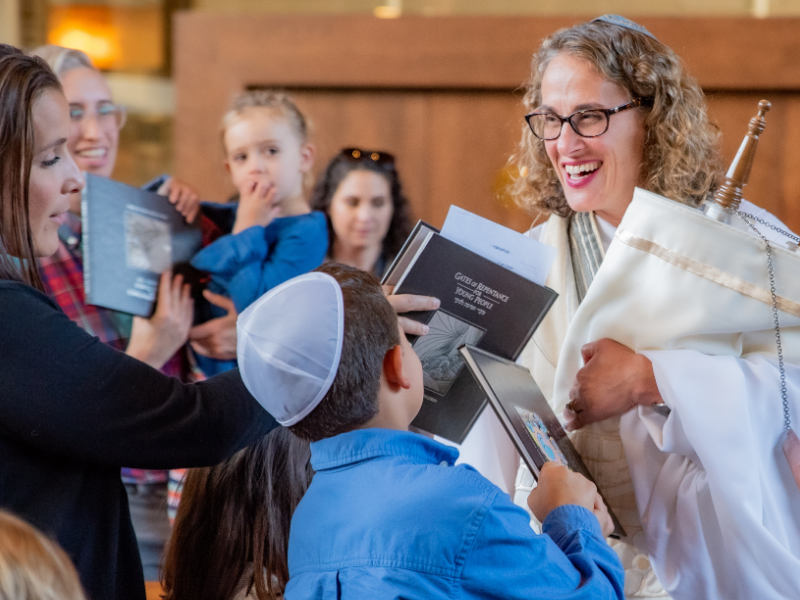This is the ritual law that the Eternal has commanded: Instruct the Israelite people to bring you a red cow without blemish, in which there is no defect and on which no yoke has been laid. You shall give it to Elezar the priest. It shall be taken outside the camp and slaughtered in his presence. . . . a man who is pure shall gather up the ashes of the cow and deposit them outside the camp in a pure place, to be kept for water of lustration for the Israelite community. It is for purgation (Numbers 19:2-9).
There are moments in our study of Torah that we step back and ask, "What the heck is going on here?" There are times when we are reading Torah and something leaves us stumped, asking, "Why? What is the meaning in this?" The mitzvah of the red heifer is just one of those moments. We are left wondering why Judaism – why Adonai – requires the slaughter of a perfectly fit and whole red cow whose ashes can then be used to ritually purify an Israelite who has been contaminated through contact with a corpse. As Jews, we are inheritors of an intellectual tradition that looks for meaning in the text beyond the answer, "because I (meaning Adonai) said so." As Reform Jews, we are linear, rational thinkers, inheritors of a German classical tradition that celebrates the ethical and questions the ritual that is seemingly bereft of the logical. So what of the red heifer? Why does a red cow restore purity after exposure to corpses?
P'sikta D'Rav Kahana records that a pagan questioned Rabban Yochanan ben Zakkai about this strange ritual, claiming that it was a form of sorcery. Rabban Yochanan answered the man by comparing the ritual of the red heifer to a similar medical practice of the day. The pagan was appeased. Rabban Yochanan's students, however, were agitated at his response, calling it a shallow rationale. What, they wondered, is the true reason for the ritual of the red heifer? Rabban Yochanan answered, "The truth is that the purifying power of the red cow is a decree of the Holy One. The Holy One said, "I have set it down as a statute, I have issued it as a decree. You are not permitted to transgress my decree."
Notice anything? Rabban Yochanan doesn't provide a reason either, because there is no clear reason. He simply asserts that we are Jews and it's a mitzvah, so we are to do it without justification. And perhaps, just maybe, in the doing there will come understanding. This idea of naaseh v'nishma--we shall do and then we will come to understand--is not easily packaged and sold to liberal Jews. We are methodical about our actions; we are conscientious regarding our engagements. And yet there are some things we do, not because they are rational, but because they link us to a shashelet shel kabbalah, "a chain of tradition," by the mere fact that others before us have done it that way as well. We light candles on Shabbat, we circumcise our newborn sons, we stand under a chuppah when we get married, and we (or at least our biblical ancestors) slaughter a red cow and use its ashes to purify ourselves when we come in contact with a corpse.
The concept of naaseh v'nishma maintains that when we do mitzvot that may not seem logical or rational on the surface, they will come to have great meaning through the repetition of performance.
Consider this story: A young woman stood cooking Shabbat dinner in her kitchen one Friday morning. Her mother sat nearby, visiting with her daughter as she cooked. The daughter took out a beautiful roast from the refrigerator and prepared it to go in the pan to be cooked for dinner. Just before placing the roast in the pan, the she chopped off an inch from either end of the roast. The mother, watching her daughter's preparation, asked, "Honey, why would you chop the ends of the roast when they are perfectly good meat?" The daughter responded, "Because that's what Grandma always did and that's what Great Grandma always did, and so that's how you make a Shabbat roast!" The mother laughed. "Honey, Grandma only chopped off the ends of the roast because her pan wasn't big enough! And Great Grandma's as well!"
Sometimes we do things not because we know why, but because they have latent emotional value for us. They are tradition. They link us back to those who came before us and connect us to community and to something bigger than ourselves. And if we have mazel, they link us back to the Divine.
Rabbi Laurie Rice is co-senior rabbi at Congregation Micah in Nashville, Tennessee, where she shares the pulpit with her husband, Rabbi Philip "Flip" Rice.
Mysterious and magical, the "red cow" interlude presents Reform Jews with the challenge of making sense out of something that seems devoid of it.
God commands the people to bring forth a parah adumah t'mimah, a "pure red cow"–one without blemish or mark that has never been used for plowing. Like much of the Torah's priestly material–such as the ideal physical attributes for priestly service (Leviticus 21) and the isolation of those with skin disease (Leviticus 13-14)–this chapter seems focused on physical perfection. It's easy to understand why: In ancient times, people viewed outward blemishes as a sign of inward contamination, a manifestation of sinful or corrupt urges burst out into the open. Thus is Miriam stricken by God with white scales (Numbers 12:10) after she thoughtlessly condemns Moses for marrying a Cushite (black1) woman.
Today, we understand a great deal about the nature of illness and affliction, whether it's a temporary skin ailment or a permanent disability. We do not connect them to spiritual corruption. We also know that physical perfection is no guarantee either of intellectual prowess or righteous spirit. So we must seek a new definition of the Hebrew word, tamim (which has the same Hebrew root as the word, t'mimah).
As it happens, it's also an ancient definition, one as old as our people. To Abraham, God said: "Walk along before me and be tamim" (Genesis 17:1). When did God say this? After Abraham circumcised himself--that is, after he had made a permanent blemish on his skin! He was no longer a perfect physical specimen, yet as Rabbi Meir, the great second-century Sage of the Land of Israel, taught: "Our father Abraham was not called 'perfect' until he circumcised himself" (Babylonian Talmud, N'darim 31b). The act of circumcision convinced God of Abraham's sincere intentions on the inside, no matter the mark it left on the outside. It was not physical perfection that God sought but rather what the Psalmist would later describe as "One who has clean hands and a pure heart" (Psalm 24:4).
Our lives may not be perfect, but if they are lived with good intentions and decent behavior, we are indeed walking before God as perfectly as we can.
-
See W. Gunther Plaut, gen. ed., The Torah: A Modern Commentary, Revised Edition (NY: URJ Press, 2005), pp. 965-973
Rabbi Audrey R. Korotkin is the spiritual leader of Temple Beth Israel, Altoona, Pennsylvania.
Chukat, Numbers 19:1-22:1
The Torah: A Modern Commentary, pp. 1,145-1,164; Revised Edition, pp. 1,022-1,042
The Torah: A Women's Commentary, pp. 915–936
Explore Jewish Life and Get Inspired
Subscribe for Emails

